As I stood on a mid-morning in July at the edge of the Rock Lake Creek, the sky was a bright blue with not a wisp of cloud and not a whisper of a breeze. The water on this mile-long meandering stretch of the South Madawaska River was clear but tea-stained by tannins and the only ripples were from the aluminum skiffs and canoes that had already left the dock. On the banks, forests of cedar, pine, and birch crowded the river and several trees leaned well out over the water, as if pushed by the trees behind them. The banks themselves were masked by a solid wall of scrub brush growing down to the water’s edge.
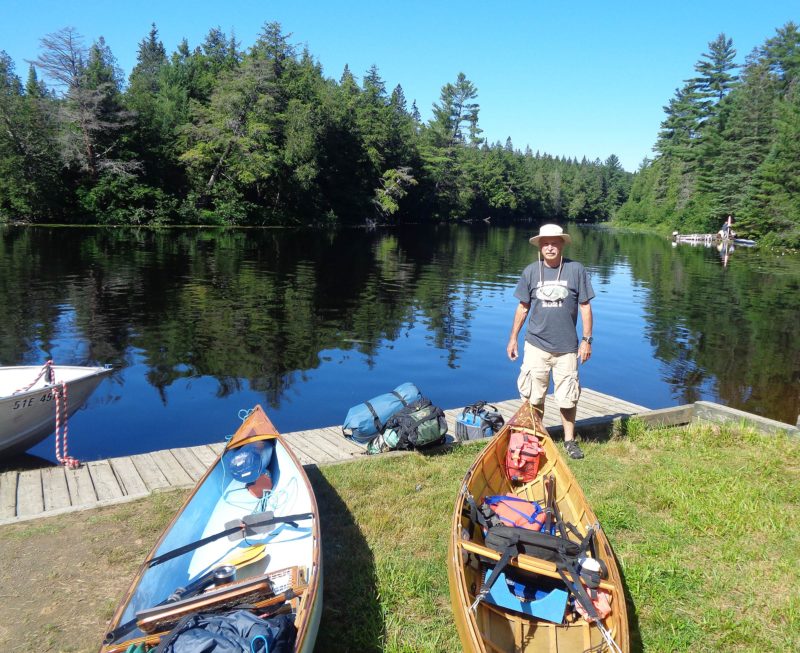 Photographs by the author
Photographs by the authorDerek would use the 32-lb strip-planked canoe I built using blue insulating sheet foam for strips rather than cedar. The canoe in front of me is one of three skin-on-frame versions I built of my Wee Bonnie series. The design has its roots in the Wee Lassie canoes built in 1880 for George Washington Sears—aka Nessmuk—by the Rushton Boat Works of Canton, New York. The dock and ramp at the Rock Lake Access Point serves recreational canoeists and residents of lakeside cabins—their outboard skiffs are limited to 20 hp by Algonquin Provincial Park rules.
My son-in-law Derek and I readied our canoes on the trampled grass at the Rock Lake Access Point set midway on the mile-long section of river between Rock and Whitefish lakes. The gear we shuttled from the car was for our four-day adventure in Ontario’s Algonquin Park; the solo canoes were Wee Bonnies that I had designed and built based on Mac McCarthy’s Wee Lassie II. I would paddle the nylon skin-on-frame boat while Derek would use the fiberglass-sheathed blue Styrofoam version. Our outing was an annual retreat for us, but this year was bittersweet. A third paddling companion, Phil, had to cancel at the last minute, and the fourth member of our usual crew, Rob, who had paddled with us for the past seven years, had passed away in February.
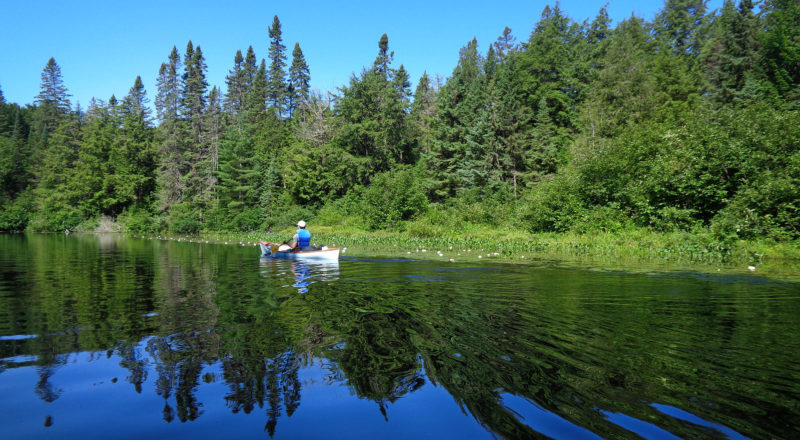
Rock Lake Creek, a section of the South Madawaska River connecting Rock Lake to Whitefish Lake, downstream to the north, made for a very pleasant first leg as Derek and I paddled quietly in the stillness.
We launched and settled into a cadence through Rock Lake Creek, a winding section of the Madawaska that leads to Rock Lake. Our destination for the day was Pen Lake, 3.5 miles downstream from the launch. The slow-flowing creek was still shrouded in the cool shade of morning, while the trees along the western side were in the amber glow of full sunlight. A few water bugs scooted away across the water’s surface as our canoes cut through the still water. Wisps of mist hung in the shaded bends of the river and the still, black water mirrored the thickets on both banks.
We paddled less than 1/2 mile before we entered Rock Lake. A group of paddlers in fiberglass canoes was milling about the gentle arc of sandy shoreline near the Rock Lake Campground. Derek and I headed south past cottages that dotted the western shore—some had solar panels on their roofs; the power grid does not reach the shores of the lake.
Late in the morning, a light breeze puffed up from astern ruffling the lake and making the paddling easier. A mile into the 3-mile-long lake the shoreline curved away to the west and steep red granite bluffs towered up over the water into a massive 100′-high wall draped with gray lichen.
Scattered cumulus clouds ghosted across the sky as the breeze strengthened and scuffed the ripples on the lake into waves that tried to push our sterns sideways. Derek and I paddled up to speed and had fun surfing ahead of the crests.
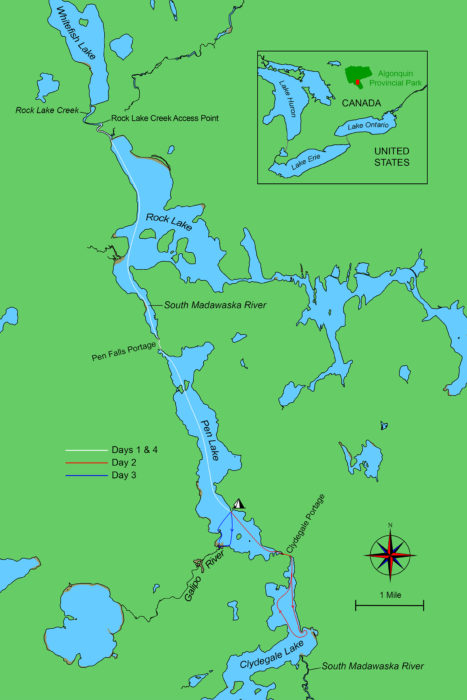 Roger Siebert
Roger Siebert.
The last mile of Rock Lake is a long, narrowing bay occupied by the South Madawaska River, with high bluffs of granite blanketed with white pine, spruce, and eastern red cedar on the east and low wetland with areas carpeted by lily pads on the west. When we heard the rapids tumbling down from Pen Lake and rumbling like distant thunder, we knew we were close to the portage.
We coasted ashore on a low shelf of tawny red granite cross-hatched with fractures. I stepped out of the canoe and carefully shifted my weight onto the slippery, muted-green algae clinging to the submerged slope of rock. A little more than 100 yards to the south, at the end of the inlet, the rapids poured out from the woods, dappling the dark-brown water white with clusters of bubbles.
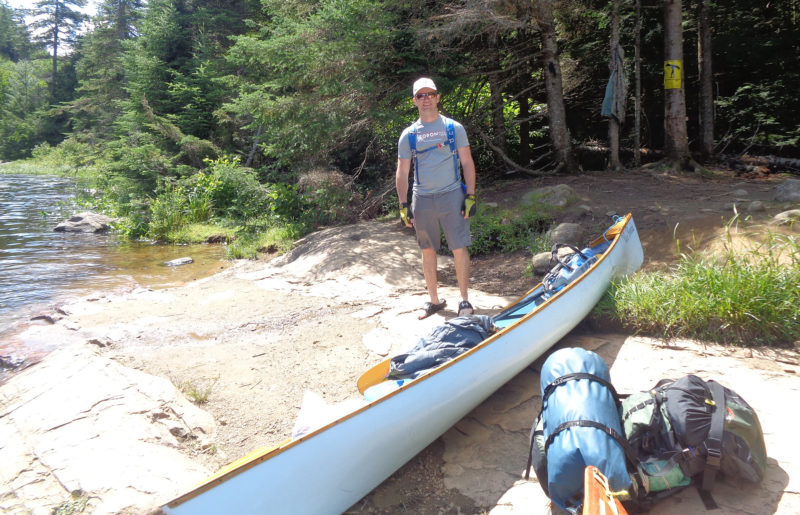
The low granite ledge made for easy landing at the Pen Falls portage. We’d make the 410-yard carry in two trips, one for the canoes and another for the gear.
The portage to Pen Lake, marked by a yellow vinyl sign that was wrapped around a tree trunk and bore the black silhouette of a single carried canoe, started a few yards away from the water’s edge in the woods. The 410-yard trail was the only portage for us and we were ahead of schedule, so we decided to make two trips. For the first haul we carried packs and then returned for the canoes. A torrential lightning storm had passed through the night before and had left the trail very muddy—ankle deep in places. Long, meandering boardwalks of graying planks set on timbers surrounded by roots and rocks all flocked with moss kept us above the areas that are perennially wet, but we still had to tiptoe through some thick muck on the rain-soaked path. The trail wound around spruce and hemlock trees as it paralleled the rapids a couple of dozen yards downhill from us. Flat rocks rising above the level of the mud often offered dry steps when we most needed them, but they could trip us up, especially when carrying the canoes, if we didn’t pay close attention.
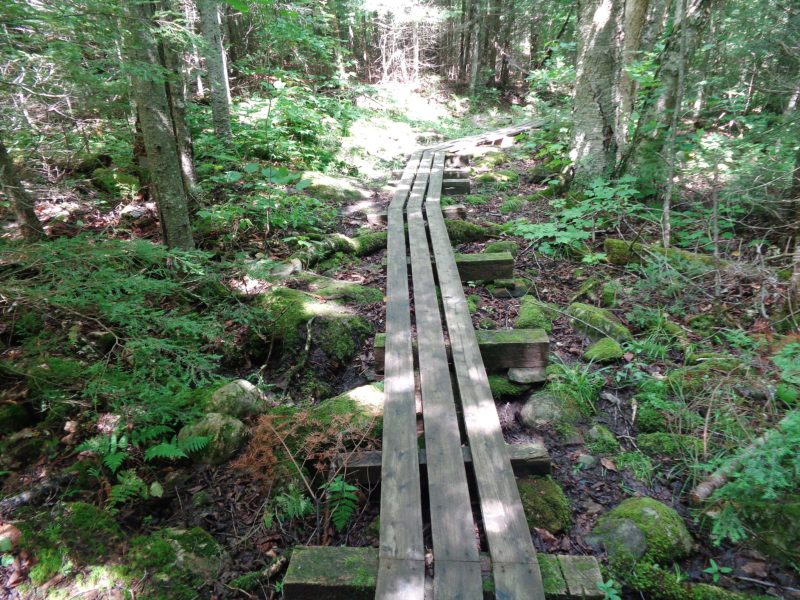
The portage trail had planked walkways over the low areas where mud could be a problem during rainy weather. The short portage was a pleasant walk beneath the canopy of the trees while listening to the sound of the rapids filtering through the brush.
The Pen Lake end of the portage had a wooden dock jutting about 50′ from shore into a long narrow cove with thick brush lining both sides. Launching easily, we pulled out into the cove, staying well away from the channel to our left that flowed into the rapids.
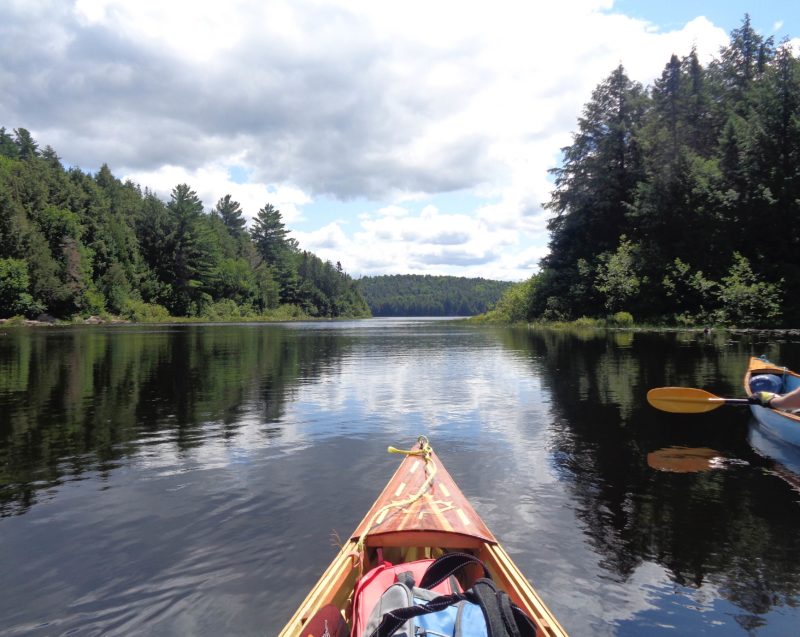
Back in the canoes again after the portage with the sound of rapids toward our port side, we paddled into the narrow entrance of Pen Lake. Some dark clouds started to appear, but the weather didn’t deteriorate.
The 70-yard-wide cove opened into a bay at the north end of Pen Lake, separated from the main body of the lake by a small peninsula and an island, each about 200 yards long. While there is an open passage to the east of the island, we took the shortcut between the island and the peninsula; between the two, at the south end of this shorter passage, there is a barricade-like line of boulders. Paddling in single file, in water only inches deep, we squeezed between two jagged boulders and slipped into Pen Lake’s 3 miles of open water. The wind had continued to build over the course of the day and when funneled between the high bluffs of rock and trees lining both sides, the northerly propelled us down the half-mile-wide lake.
We headed for our intended campsite, concealed somewhere in the unbroken eastern edge of the shoreline forest about three-quarters of the way down the lake, but as we drew near, we could see that some other party had beaten us to it. We paddled back to a campsite we had passed earlier. It was a site veiled by thick brush until we got right up to it and could see how spacious it was. At the water’s edge was a partially submerged row of large granite blocks, once a continuous shelf, now separated by erosion-widened parallel fractures. Above, resting on the ground at the front of the trees surrounding the campsite, was a lone rough cube of granite 5′ high and 7′ wide.
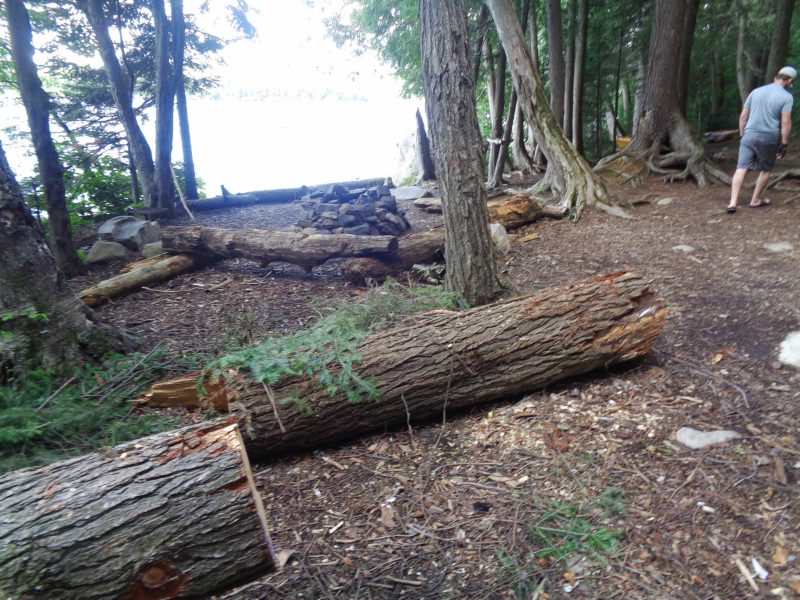
At our campsite there were some large freshly cut logs off to one side, but it was mostly a large open area in the midst of the woods. The stone fire pit was surrounded by log benches which is typical of campsites in Algonquin.
At the back of the campsite a row of fir logs 10′ long and about 20″ in diameter lay in a broken row next to a stool-high stump. The tree had been recently cut and still had some fresh boughs on and alongside of the logs. Usually, any tree that has the potential to topple or has been damaged by a storm will be cleared up by the park crews to ensure the safety of the designated campsites. Eventually these logs will either go to firewood or be positioned around the campfire for seating.
The fire pit, ringed high with neatly stacked stone, had been blackened by countless fires. The ground around the pit was covered with wood chips left by axes chopping firewood. Three bark-bare logs were set up as seating.
The whole campsite area was clear of brush and had a thick blanket of white-pine needles (which seemed strange considering that most of trees were firs, many with trunks more than 2′ in diameter). Any branches within reach had been pulled down for firewood.
Derek set up his tent while I stretched my hammock between a pair of trees. By the time we had finished setting up camp and gathering firewood, we had both worked up a sweat. It was time for a swim. Broad granite ledges at the lake’s edge extended underwater; I edged down to a lower shelf and made a shallow, skimming dive. I gasped as I hit the water; the day’s north wind had churned up the shockingly cold water from the depths of the lake. After our dip, Derek and I climbed out of the water to dry off and warm up on the sun-bathed ledges. On the far side of the lake, less than a half mile away, a hill covered in the luscious greens of cedar, pine, fir, and balsam was flecked with shimmering white and yellow birch. The cove across the lake was a thin, luminous line of grasses and lily pads separating the forest from the water.
As Derek and I lounged in the sun, a few loons swimming just offshore ducked under the water and disappeared. When they resurfaced, they spread their wings as if to shake off the water. A pair of mergansers with rusty-red heads swam toward the base of the rock shelf, saw us, and quickly moved away.
That evening we fired up the camp stove and I warmed up a precooked frozen chicken breast that had thawed during the day’s trip and added a spinach salad with lots of berries; Derek cooked steak and beans. As we prepared our meals, two red squirrels, used to associating campers with food, circled around us getting braver and closer looking to steal any morsel they could.
Supper over, it was time to hang the food bag in a tree well outside our campsite. Black bears and raccoons inhabit the area, so hoisting the bag up 12′ was the safe thing to do.
Before turning in for the night, Derek and I sat at the water’s edge as the color ebbed from the sky and waited for the stars to shine. Planets were the first to emerge from the twilight: Venus gleamed above us and to the northwest Mars was a small glimmer of red. A single satellite, as bright as most stars, made its unwavering passage across the sky. It was not long before the full moon rose and its bright orange glow swept across constellations, making them unrecognizable. Moonlight brought the landscape out of darkness making it brighter by the minute. We decided to hit the sack.
The morning was bright with a clear sky except for the dusty streaks of high clouds. There was not even a breath of wind, and the water was calm. I made a cup of coffee and sat on the granite ledge as the morning air warmed. In the stillness the lake mirrored sky and the silhouette of the far shore. I heard what I thought was a frog croaking, but it was the sudden burst of a large hummingbird darting behind me. An invisible loon on the far shore then let out a loud squawk; a far cry from the haunting, hollow whistle that loons are known for.
I noticed two large animals poke out of the far shoreline and start to wander in and out of the shore brush. They were too light in color to be moose, too big perhaps to be white-tailed deer. Derek joined me and he guessed that we might be seeing elk, which had been reintroduced to the park in 2001.
With breakfast over, it was time to ready the boats for a day trip to check out Clydegale Lake, farther south of Pen. The portage to Clydegale was over a mile away but a pleasant paddle with a north breeze behind us again. We paused near a pair of loons as they dove, disappeared, and resurfaced a dozen yards away.
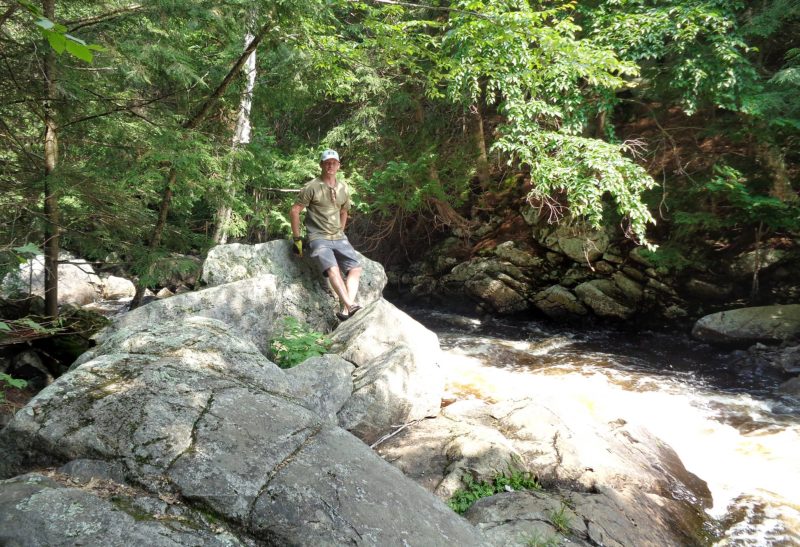
Behind Derek is the torrent of water crashing from Clydegale Lake to Pen Lake. He left his gear and his canoe at Pen to do some paddling there while I explored Clydegale.
It took just a few minutes to carry my canoe along the 300-yard portage to Clydegale. Derek walked with me without his canoe; I was going to paddle alone on Clydegale while he would do some exploring on Pen. I walked with him back along the trail to go down and explore the rapids of the 1/10-mile-long section of the South Madawaska River that flows from Clydegale into Pen. The thunderous rapids crashed and foamed over blocks of granite. Beneath the thick canopy of the trees overhead, a high rock wall on the opposite side funneled the rapids around a sharp bend above the tumble into Pen.
Venturing out into Clydegale by myself was peaceful. There were only a few camps on the lake, and I saw only one with campers; I welcomed the uncommon sense of just being alone. The occupied campsite was on the east shore and perched about 15′ above the lake on the top of a cliff-like rise. The climb up and down could be a bit tiring, but the great view of the sunset would be worth the effort.
The northeast breeze had strengthened and propelled my canoe quickly down along the east shore and to the end of a narrow, 100-yard-long rocky peninsula fringed with scrub brush. I ducked into the small cove in its lee, and floated untouched by the wind. White pines towered over the point and in the still air of their lee, the sunlight felt very hot on my head and bare arms and the perspiration started to roll down my brow. The water here was dotted with the green circular pads of lilies and their white and yellow star-like flowers. The cove to the west stretched far inland changing from fields of lilies to low grassy wetlands to verdant hills in the distance.
Exploring the rest of the 3-mile-long lake would take hours and the wind would slow the return to the portage, so I paddled toward the west shore on a northwesterly course to avoid going directly into the wind and waves. I pushed hard against the foot brace to get the extra power I needed.
It took a bit of effort to get back to the portage and then another push to paddle upwind on Pen Lake to return to camp. Derek was already there, sitting on the large granite block above the shoreside shelf.
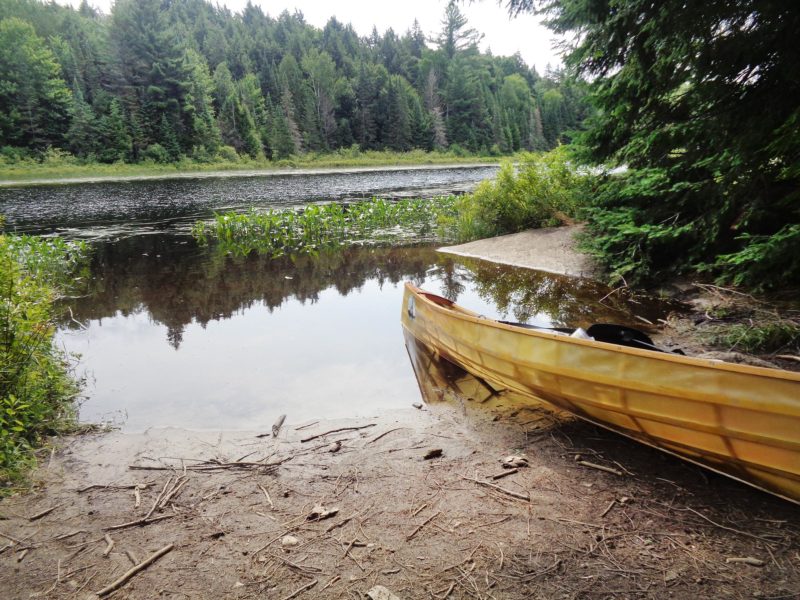
At the end of the portage, I set my canoe down at the muddy entrance into Clydegale Lake. The narrow north end of the lake is a shallow, peaceful place with lily pads almost completely surrounding the passage.
After I pulled my canoe ashore, we searched for firewood to get us through the evening. It had been rainy for the past month, and I worried that there wouldn’t be any dry wood, but we found some well-dried cedar and birch.
Our chores done, we took a quick, brisk swim. The northeast wind made it a bit chilly as we sat to dry off on the ledge. As dark clouds quickly moved in, four loons out in the lake called back and forth. A bald eagle glided past in front of us some 50′ above the water and the loons cried in panic. The eagle soon disappeared in the distance. A blue heron flew toward us only to make a sharp turn away when it saw us sitting on the rocks.
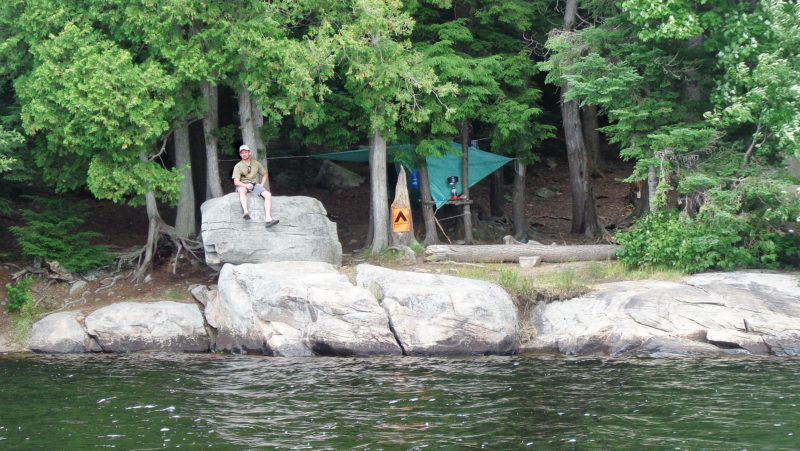
Our camp on Pen was not where we had planned to stay—that site was occupied—but it had plenty of room and great seating for watching the sunsets and stars.
There was a quick shower that evening, and the sky cleared up enough for some stargazing. The clouds that remained blocked the moon enough that the open part of the sky was filled with stars. The Big Dipper was right overhead. We stayed up until 11:30. It was a luxury to sit out in the open air—the mosquitoes were hardly noticeable. In years past, we had to retreat to our tents to avoid them.
The morning was as still as it had been the previous day and we were eager to venture along the far side of Pen Lake to the cove where we had seen the deer or elk the day before, at the mouth of the Galipo River. The cove was covered in waterlilies and bristling with bamboo-like stalks that had had their tops bitten off, probably by moose, several inches above the water.
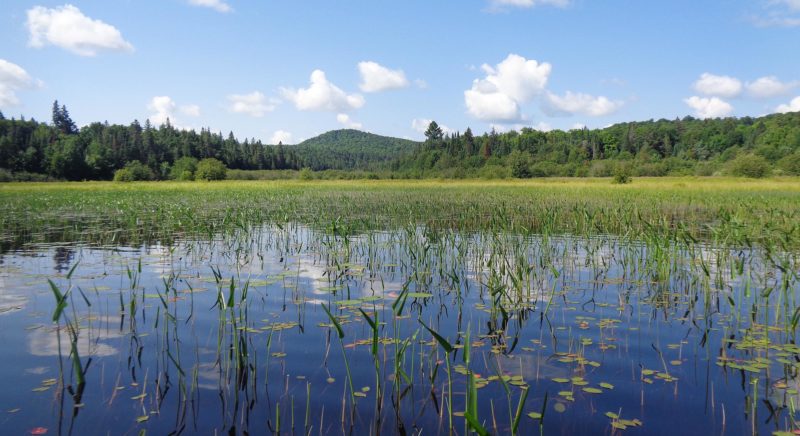
The expansive cove on the west side of Pen Lake was covered with waterlilies. Paddling the shallow water here required some caution to avoid colliding with deadheads hidden just below the surface.
As I paddled among the stalks, they scraped the canoe’s nylon skin and made a muted version of the sound made by hand-cranked sirens used at hockey arenas to excite the crowd. The paddling became more difficult as I moved into an area of watershield, an aquatic plant with floating leaves like waterlilies that so completely covered the surface of the water that my paddle would bounce off them.
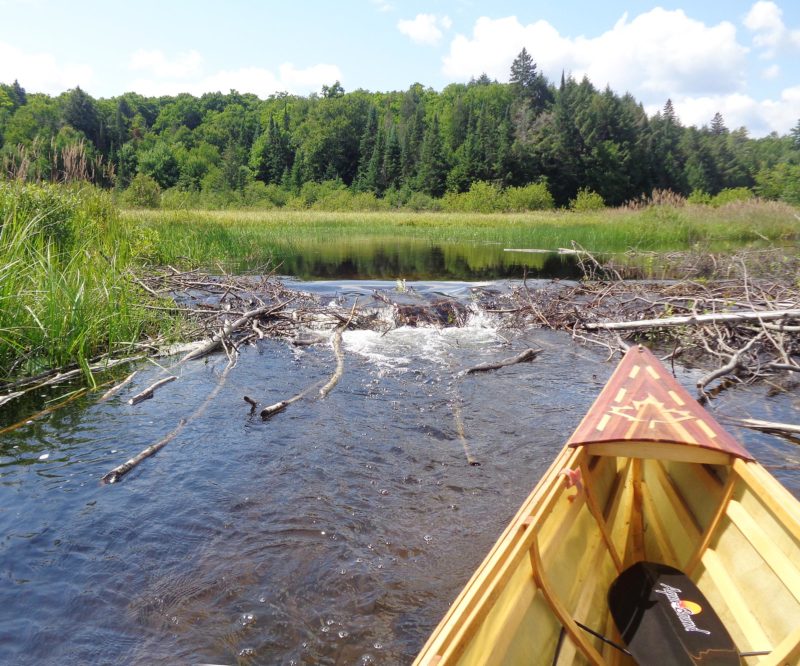
The blockage that deterred the Galipo River’s flow from Welcome Lake into Pen Lake was probably a beaver dam’s tangle of logs, but it had just enough head for the water flow to carve a channel through the lilies and sand and still allow for a crystal-clear view of the channel bottom.
I worked my way along the shoreside wetlands to a 12′-wide channel the river had carved out. The sandy bottom a couple of feet below was clearly visible. I turned into the strong current and paddled upstream toward the sound of falling water. The meandering stream bounced me off the channel edges, which were no more than wetlands of brush and lily pads. Rounding a bend, I found the source of the noise: a large log tangled with branches blocking the river, likely a beaver dam. Water tumbled over and through it, creating plenty of turbulence. I turned around and scooted out with the current. I rejoined Derek and we turned north out of the cove and headed for an island just 50 yards wide, making our way behind it by sneaking through the boulder-strewn shallows that connected it to the mainland.
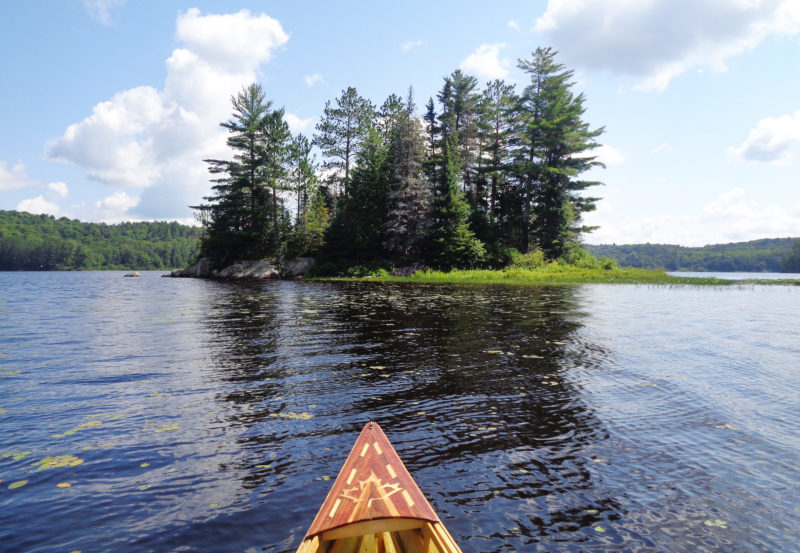
This small island at the north end of the cove sat just a few dozen yards from shore loosely connected to the mainland by a string of boulders. We were able to paddle between them on our way back into the main body of the lake.
Cutting back across the lake to our camp we pulled the canoes carefully up and away from the rocky shore. We spent the evening warmed by the campfire and did a bit of stargazing before we hit the sack.
Morning came with an overcast sky and a breeze that was just a hint of movement coming from the south. We cleaned up camp, loaded the canoes, and were off with an early start, thinking the southerly might bring some showers or even a storm.
The following breeze made for an easy paddle and felt nice as we headed north. It was not too long before the breeze increased to a steady wind, raising waves we could surf.
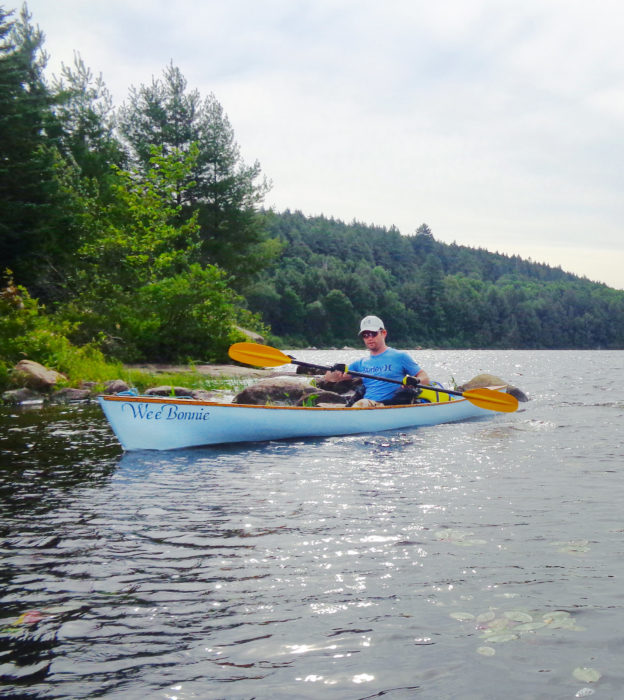
On our final day we squeezed through the boulders at the north end of Pen Lake; the 6″ depth of the water was all we needed to make it through. The light southerly breeze helped us to glide through the opening as we headed back to the portage to Rock Lake.
In no time we were cutting between the boulders at the north end of the lake and gliding into the wooden dock of the portage. We had the portage to ourselves and wasted no time getting to Rock Lake for our final push, enjoying the good fortune to have the wind always at our backs. ![]()
Phil Boyer retired in 2017 after working 38 years in R&D in the telecommunications industry. He now keeps busy teaching karate at two local clubs and building boats. He has been around boats his whole life, starting with paddling as a kid. At age 11 he built a sailing pram with a bit of help from his father. In 2006 he began building solo canoes and now has four of them, featured in the August 2019 issue. Phil’s interest turned to building SOL CANADA, his solar-electric boat, in 2015. His next build will be a solar-electric version of the Power Cat he read about in the March 2016 issue of Small Boats Magazine.
If you have an interesting story to tell about your adventures with a small boat, please email us a brief outline and a few photos.
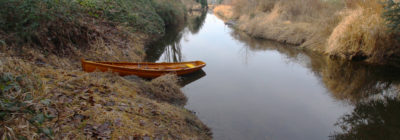
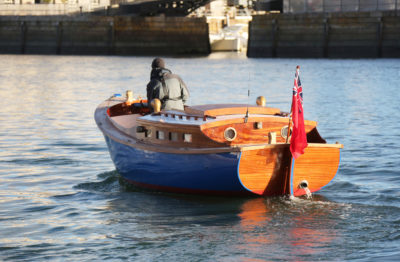
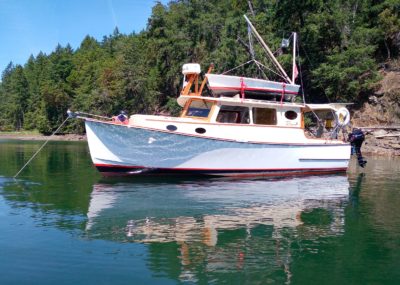
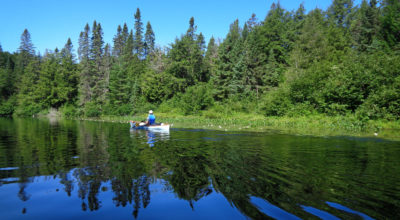
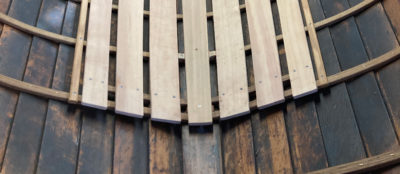
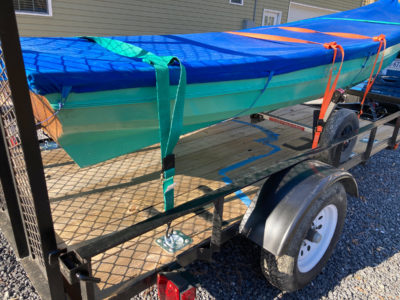
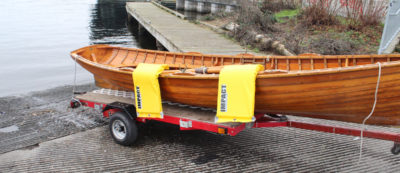
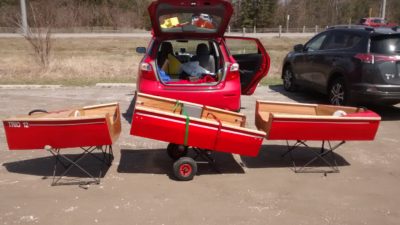
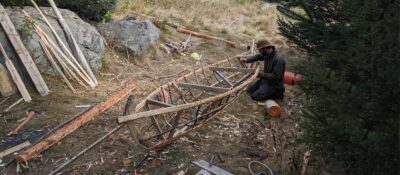
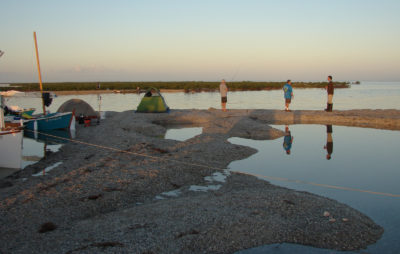
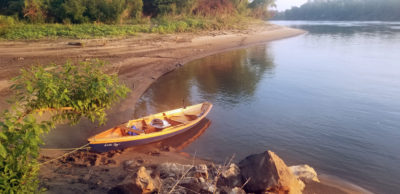
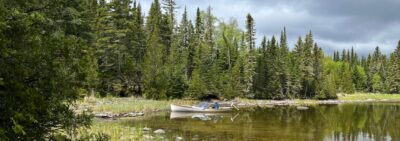
Thanks for the article on Algonquin Provincial Park. My dad paddled there in the early 1950s with a friend and it has been on my list to paddle all my adult life. Some day…
I do have questions about your Styrofoam Wee Bonnie:
1) What were the dimensions of the foam you used?
2) Does one have to work with a specific type of Styrofoam so it doesn’t interact with the epoxy resin?
3) Based on your experience, is there anything you’d change with regard building a boat using this technique?
Thanks in advance,
Barry
Though I am not the original author, I can comment on your question. Polyester resin eats up styrofoam; epoxy seems to have no adverse effect.
In addition, poly makes a very poor glue, unlike epoxy, which is a superior glue. When home builders first started glassing their boats, they had access only to poly. Eventually, the glass tended to delaminate. When I have built plywood kayaks (Pygmy kit boats), I have always used epoxies, and wouldn’t use anything else.
A friend of mine who builds beautiful glass kayaks prefers vinylester resins for his layups.